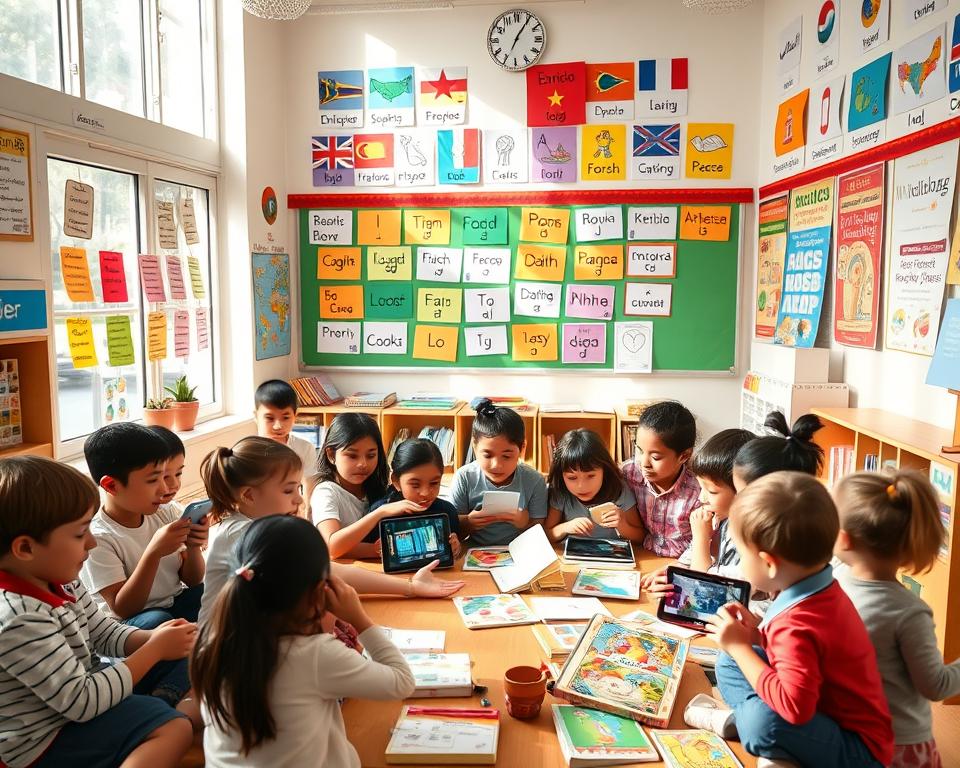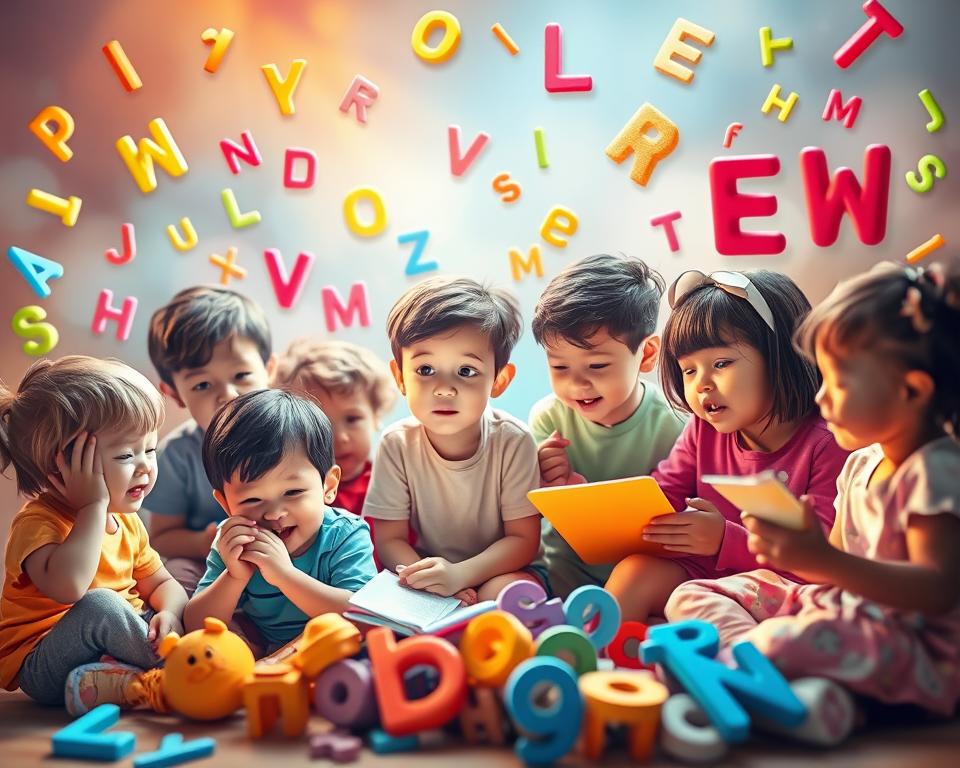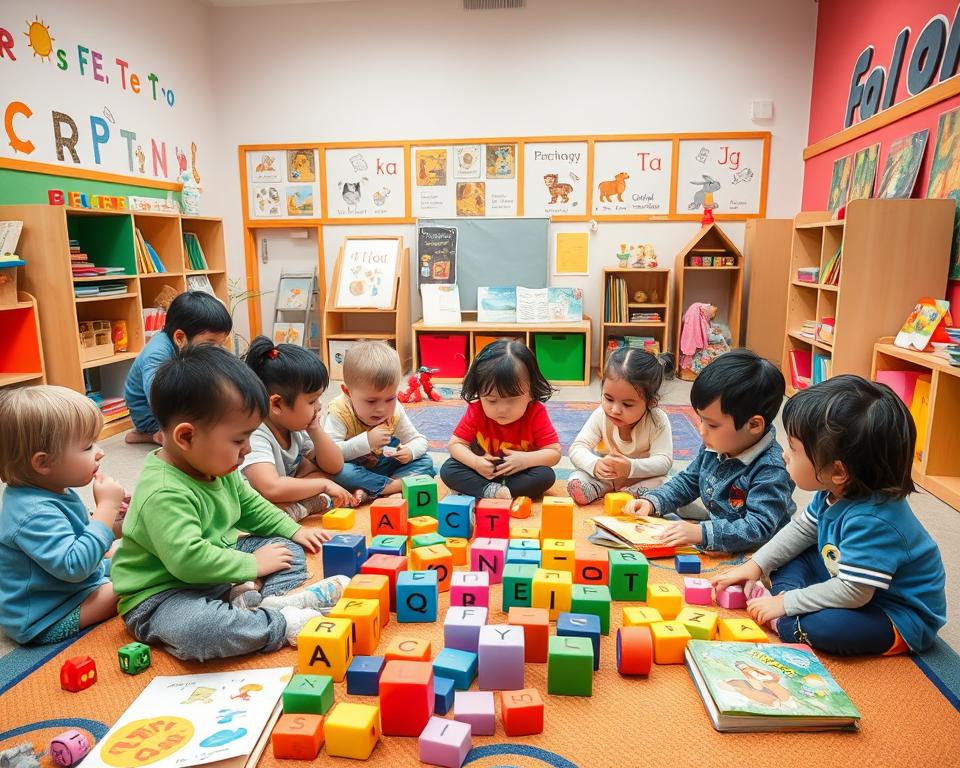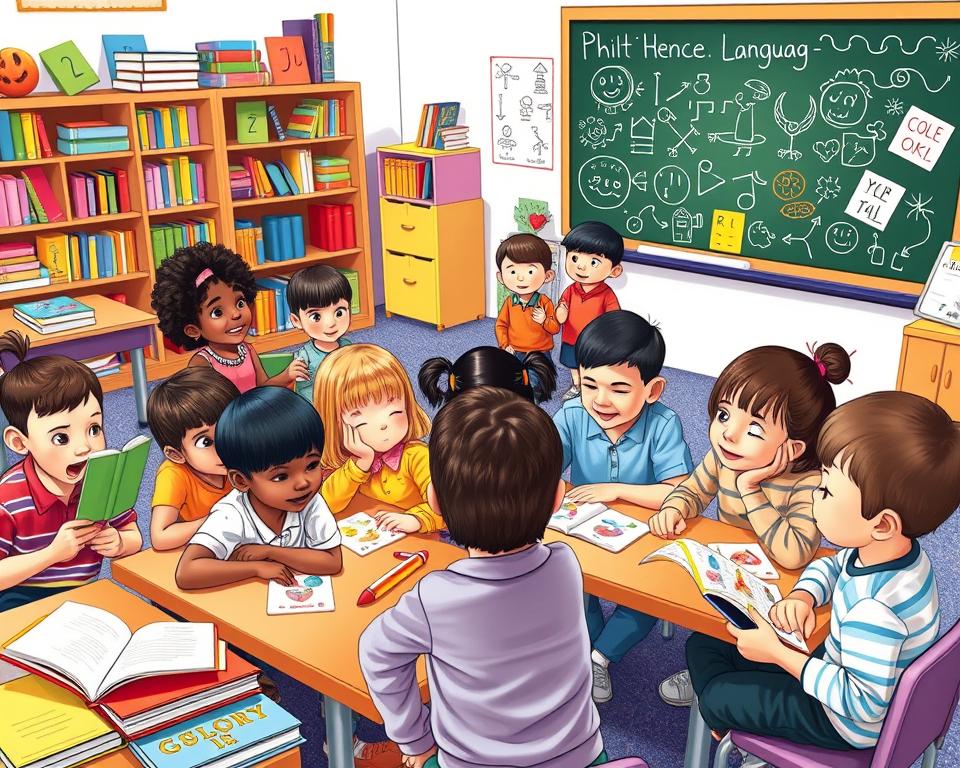Teaching Children New Languages: Expert Guide
Did you know that it can take a child 5 to 7 years to advance in a new language? This shows how much learning a new language can help a child’s brain and schoolwork. Kids from birth to three are especially good at learning new things. The importance of learning how to teach children new language comes in.
Learning a new language might seem hard at first, but kids can pick up many languages easily. The most important thing is for parents to speak the language they feel most comfortable with. This helps kids learn naturally.

Understanding the Benefits of Early Language Learning
Teaching foreign languages to kids early on brings many benefits. It boosts their thinking skills, cultural understanding, and future success in school. Studies show that young bilinguals are better at solving problems, thinking creatively, and focusing than kids who speak only one language.
Cognitive Development Advantages
Children who learn two languages have more brain activity. Better memory, multitasking, and decision-making are associated with this. Learning a new language also boosts their confidence in many areas of life.
Cultural Awareness Benefits
Knowing a second or third language broadens a child’s view of the world. It helps them connect with their family’s history and traditions. They also gain a deeper appreciation for different cultures and ways of life.
Future Academic Success
Knowing multiple languages opens up more job opportunities and can lead to higher salaries. Colleges also value students who speak more than one language. This can give them an edge in a competitive college admissions process. Students who study foreign languages for four or more years score higher on tests than those who study for less than half a year.
Starting language learning early is a smart investment in a child’s future. It improves their thinking, cultural understanding, and job prospects. With regular practice, kids can become multilingual, setting them up for success in school and beyond.
The Science Behind Children’s Language Acquisition
Learning how kids pick up new languages is key to good teaching. Kids use two main ways to learn: without thinking (unconscious) and with thinking (conscious). At first, they mostly use the unconscious way. But as they get older, they start to use conscious memory more.
Children are great at picking up language rules without even trying. This is different from adults, who learn better when they think about it. Kids learn new language patterns easily through play and talking, helping them remember better.
“At around 12 years of age, learning a new language starts to become more difficult as the conscious memory system develops more strongly.”
Early language programs are very helpful. Research shows kids learn more when they learn subjects in a new language. This fits with how kids naturally learn languages without studying.
Adults might find it challenging to learn complex language parts. But early language immersion programs can help them get used to foreign speech patterns. Just listening to podcasts in another language can help them learn better later on.
The science of how kids learn languages shows us how to teach them better. By using what we know, we can make learning fun and effective for kids. This helps them grow and succeed in language skills.

One of the key aspects of language acquisition is the development of phonological skills, which involves the recognition and production of speech sounds. Babies are born with the ability to distinguish between different phonemes, or the smallest units of sound in a language. As they are exposed to spoken language, they begin to categorize and store these sounds in their memory, forming the basis for understanding and producing words.
Another crucial component of language acquisition is semantic development, which involves learning the meanings of words and how they are used in context. Children start by acquiring basic vocabulary and gradually learn more complex words and their meanings through exposure to language-rich environments. This process is supported by the brain’s ability to make connections between words and concepts, which helps children build a mental lexicon of words and their meanings.
Syntax and grammar play a vital role in language acquisition as well. Children start by learning simple sentence structures and gradually acquire more complex grammar rules as they develop. This process is facilitated by the brain’s capacity for pattern recognition and rule learning, which allows children to understand and produce increasingly sophisticated language structures.
Social interaction also plays a crucial role in children’s language acquisition. Research has shown that children learn language best through interaction with caregivers and peers, who provide them with opportunities to practice and refine their language skills. Conversations, storytelling, and play activities all help children develop their language abilities and communicate effectively with others.
Thus, children’s language acquisition is a complex and dynamic process that involves multiple cognitive and social factors. The brain’s ability to process and store language information, combined with social interaction and exposure to language-rich environments, all contribute to the development of children’s language skills. Understanding the science behind language acquisition can help parents, caregivers, and educators support children’s language development and foster effective communication skills.
How to Teach Children New Languages: Core Principles
Teaching children new languages is a rewarding journey that boosts their cultural and cognitive growth. It’s all about making learning fun and engaging. By understanding how kids learn languages, we can make it enjoyable and effective.
Natural Learning Methods
Teaching kids new languages should mimic how they learn their first one. Immersion helps by making the language a part of their daily life. Adding learning through association makes it even faster.
Age-Appropriate Techniques
- For toddlers and preschoolers (ages 2-5), keep it consistent and fun. Use games and activities that feel like play.
- School-age kids (ages 6-12) do well with a mix of formal lessons and practical use. Games, stories, and real-life examples work great.
- Teenagers (ages 13-17) need to set goals and reflect on their progress. This helps them feel in control of their learning.
Creating Language-Rich Environments
Surround kids with the language they’re learning. Use interactive media, books, music, and conversation. Regular practice is key for lasting progress.
“The more opportunities children have to engage with a new language in meaningful and enjoyable ways, the faster they’ll develop proficiency.”
By using natural methods, age-specific techniques, and rich language environments, we can inspire a love for language. This sets kids up for success in their multilingual journeys.
Common Myths and Concerns About Bilingual Education
When we talk about teaching kids multiple languages, many myths come up. But research has shown that these myths are not true. Learning many languages is good for kids from a young age.
Some think that kids learning two languages will get confused or talk late. But bilingual children do not have delayed speech. They often get better at solving problems and handling many tasks at once.
Another worry is that kids with special needs can’t learn a second language. But research proves that kids with speech or language disorders can learn new languages. Being around many languages can help them talk better and fit in socially.
- Bilingual children show stronger cognitive skills compared to monolingual children.
- Bilingualism enhances a child’s ability to engage in diverse conversations with individuals from different cultural and linguistic backgrounds.
- Bilingual or multilingual individuals are more marketable in the workforce.
Many believe that kids who don’t speak English at home get confused in school. But they actually pick up English faster if they know their native language well. This shows how important it is to teach kids languages at the right age.
“Children typically speak their first word around 12 months and start using two-word phrases by 24 months, regardless of the number of languages they are exposed to.”
In today’s world, speaking many languages is a big plus. By clearing up myths and seeing the benefits, we can help kids succeed in a world full of different languages.

Effective Teaching Strategies for Different Age Groups
Teaching languages to kids requires understanding their unique needs. Each age group has its own way of learning. From toddlers to teenagers, we need to use the right techniques to help them learn.
Toddlers and Preschoolers (Ages 2-5)
Preschoolers love new languages and learn through play. We use visual aids and songs to help them. They also learn by listening to stories and playing games.
School-Age Children (Ages 6-12)
Younger kids (ages 5-7) learn best with games and fun exercises. These help them with listening and basic words. Older kids (ages 7-10) start to work together more, improving their speaking skills.
Teenagers (Ages 13-17)
Middle school kids (ages 11-14) can focus on improving their language skills. High school students (ages 15-17) dive into deeper discussions. They learn more about culture and how to interact in the language.
Teaching strategies for each age should match their needs. We aim for fun, feedback, and building confidence.
“The most effective education is aimed at acquiring a basis of knowledge and developing skills to apply that knowledge in real life.”
Immersion Techniques and Their Impact
Immersion experiences are the most effective way to learn a new language. Early language immersion programs are very effective for teaching foreign languages to children. They help kids develop strong language skills.
Studies show that kids as young as 3 can learn a lot from language immersion. Their ears and speech muscles are very flexible. This helps them pick up the sounds of a new language quickly.
Experiences like watching movies, listening to songs, and playing video games in the target language are great. They make learning fun and real. When motivated, kids who learn through immersion tend to speak more fluently.
“Immersion programs like the one at ISP foster cultural appreciation by immersing students in the language and associated culture, leading to enhanced understanding, empathy, and intercultural communication skills.”
The critical period hypothesis says that kids can become fully fluent in a language by age 8. Adults can’t reach the same level. So, immersive experiences are key for kids.
Programs like English Adventures with Cambridge‘s Minecraft World offer fun ways for kids to practice their language skills. They learn in a real and engaging way.

In summary, early language immersion programs and introducing foreign languages to children through immersive experiences are very powerful. They greatly impact language learning, thinking skills, and cultural understanding. They help young learners become confident, bilingual, and ready for the world.
Use Technology and Digital Resources
In today’s world, technology plays a big role in teaching kids new languages. Fun language learning activities for kids and age-appropriate language learning for children are now part of many apps and online tools. These tools help kids learn every day, even when they’re busy.
Educational Apps and Games
Some apps focus on teaching English or helping bilingual kids. Many online tools also help teachers teach different types of learners. Games and social media can make learning English fun and help kids get ready for school and work.
Online Learning Platforms
Platforms like Khan Academy teach in 12 languages, helping English Language Learners. Tools like Microsoft OneNote and Google Translate help with language practice. They make learning more personal and fun.
Interactive Media Tools
Technology helps with translation, but it’s not everything. It’s also about understanding how to speak and the culture behind words. Tools like Explain Everything and Padlet help kids work together and learn in a real way. There are also apps for learning outside of class, tailored to each child’s needs.
Using technology wisely can make learning a language fun and engaging. It helps kids become better at speaking and doing well in school.
“The use of technology in language learning can be a game-changer, providing students with a diverse range of interactive and personalized learning experiences.”
Monitoring Progress and Assessment Methods
It’s key to track how kids learn new languages to help them grow in multiple languages. Teachers use many ways to check how well students are doing and adjust their teaching to fit their needs.
There’s a six-stage model for learning a new language: starting, early talking, speech growth, first fluency, better fluency, and advanced fluency. How fast a child gets to the advanced stage can vary. It might take 5-7 years for some and 7-10 years for others, depending on their first language skills.
When checking how well kids speak, we look at both everyday talk and school language. They might seem to talk well in casual chats but find school language hard. Informal assessments help see how kids are doing all year, adding to what tests show.
- Tests like oral reports and written work show how kids are improving in language.
- Portfolio assessments let kids pick their best work, set goals, and make rubrics.
- Special scoring and help in tests help English Language Learners show what they know, not just their language skills.
Using different ways to check progress and getting kids involved helps teachers see how kids are doing. This way, teachers can make good choices to help kids learn in multiple languages.
“Ongoing assessment is crucial for English language learners, as standardized tests may not accurately reflect their true abilities.”

Supporting Language Development at Home
Parents are key in helping their kids learn new languages, even if they only speak one at home. By using their own language when talking to their child, parents offer consistent practice. This is vital for kids to learn and grow in their language skills.
Daily Routines and Activities
Making language learning fun is easy with daily activities. Labeling items, reading books, singing songs, and watching videos in the target language are great ways to start. Setting aside time each day for language practice helps make it a regular part of the child’s routine.
Family Involvement Strategies
Getting the whole family involved in language learning creates a supportive environment. The “One Person One Language” method is popular for raising bilingual kids. It means each parent speaks a different language with the child. Including grandparents, siblings, and other family members in language activities like storytelling and game nights can also help.
Cultural Integration Tips
Introducing kids to the culture of the target language adds depth to their learning. Exploring cultural events, festivals, and traditions related to the language can spark their interest. Using media like books, music, and movies in the target language helps kids connect with the language’s cultural richness.
Key Takeaways
- Early language learning offers numerous cognitive, cultural, and academic advantages for children.
- Children from birth to 3 years old are highly receptive to new language acquisition.
- Parents should use the language they’re most comfortable with to provide clear linguistic models.
- Initial confusion may occur, but children can quickly adapt and master multiple languages.
- Consistent language practice, even for just 30 minutes a day, is crucial for language learning success.
Source Links
- Language Acquisition: An Overview – https://www.colorincolorado.org/article/language-acquisition-overview
- The Best Ways to Learn a Language According to Research – Ledger – https://campuspress.yale.edu/ledger/the-best-ways-to-learn-a-language-according-to-research/
- Raising multilingual children: the benefits of early language learning – https://school-education.ec.europa.eu/en/discover/news/raising-multilingual-children-benefits-early-language-learning
- Top 10 Benefits of Learning a Second Language at an Early Age – Spanish Immersion Workshop – https://spanishiw.com/top-10-benefits-learning-second-language-early-age/
- Why do children learn languages more effortlessly than adults? – https://unric.org/en/why-do-children-learn-languages-more-effortlessly-than-adults/
- Bilingualism in the Early Years: What the Science Says – https://pmc.ncbi.nlm.nih.gov/articles/PMC6168212/
- The most effective language learning strategies – https://mangolanguages.com/resources/learn/general/how-to-learn-a-language/your-learning-language-guide/the-most-effective-language-learning-strategies
- The 10 best language teaching strategies explained! – https://sanako.com/the-10-best-language-teaching-strategies-explained
- ACTFL | Guiding Principles for Language Learning – https://www.actfl.org/educator-resources/guiding-principles-for-language-learning
- Am I Confusing My Child? Bilingual Education & Common Myths – https://www.sunnydays.com/blog/myths-bilingualism
- Young Children Learning Multiple Languages: Parent FAQs – https://www.healthychildren.org/English/ages-stages/gradeschool/school/Pages/7-Myths-Facts-Bilingual-Children-Learning-Language.aspx
- Effective Strategies for Teaching ESL Across Age Groups – https://5minuteenglish.com/effective-strategies-for-teaching-esl-across-age-groups/
- PDF – https://articlegateway.com/index.php/JHETP/article/download/5061/4828/9222
- How language immersion positively impacts young brains | International School of Portland – https://intlschool.org/how-language-immersion-positively-impacts-young-brains/
- The benefit of immersive language-learning experiences and how to create them – https://www.cambridgeenglish.org/blog/the-benefit-of-immersive-language-learning-experiences-and-how-to-create-them/
- How to Use Technology to Support ELLs in Your Classroom | Common Sense Education – https://www.commonsense.org/education/articles/how-to-use-technology-to-support-ells-in-your-classroom
- How to use technology for learning – https://www.cambridgeenglish.org/learning-english/parents-and-children/how-to-support-your-child/how-to-use-technology-for-learning/
- The use of digital technology in foreign language learning – SN Social Sciences – https://link.springer.com/article/10.1007/s43545-021-00254-y
- Using Informal Assessments for English Language Learners – https://www.colorincolorado.org/article/using-informal-assessments-english-language-learners
- Monitoring Children’s Progress in Language & Literacy in the Early Years | Cox Campus – https://learn.coxcampus.org/courses/monitoring-childrens-progress-in-language-literacy-in-the-early-years/
- Creating a Language-Rich Environment at Home: A Guide to Supporting Language Learning – https://tessais.org/how-to-support-language-learning-at-home/
- Easy Ways to Teach Your Child a Foreign Language From 0-6 Years – https://www.theculturedkid.com/blog/nurture-language-development



